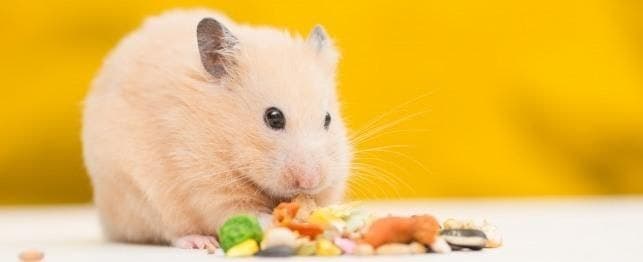
Feeding Your Hamster
Your hamster is an enthusiastic eater, and his next meal may be the highlight of his day. With high metabolic requirements, hamsters find themselves chewing through 10 percent of their body weight in food every 24 hours. By maintaining a well-balanced diet, you will increase your critter’s chance of leading a long and healthy life. His diet should consist mostly of grains and other carbohydrates, and fresh water should always be available.
Most experts recommend that you restrict the amount of sweet and oily foods that you give your hamster. While your pet may like potato chips and cupcake crumbs, these foods distract him from the nutritious items he needs to stay healthy.
Recommendations
Hamsters use their large cheek pouches like a backpack for carrying food. In their native desert lands, food is often difficult to find, and it makes sense for the hamster to collect seeds, plant roots, and small insects and hide them whenever the food is available. Hamsters can carry up to half their body weight in food in their cheek pouches. Their common name is adapted from the German word hamstern, which means to horde.
In the wild, a hamster can be quite a pest, hiding up to 60 pounds of grain in underground stores for winter.
While a hamster with his cheeks full may be hard to resist, try to avoid overfeeding your hamster. The food he stores may soon become moldy if he urinates on it to mark it as his own. You should feed him a complete hamster mix that has a variety of grains, corn and vegetable flakes in it. Hamsters require more fresh fruits and greens than many other rodents, so be sure to provide broccoli, apples, peas in the pod, melon and other fresh vegetables. Do not peel the veggies or remove their seeds – your hamster will enjoy shredding the whole piece at his own pace. And do not be surprised if you see your hamster eating his droppings. It is difficult for him to get all of the nutrients he needs out of his food the first time it passes through his gut.
Water
Fresh water should be available to your pet at all times. A sipper bottle is the best way to supply water to your pet because it won’t become contaminated with food and feces. It’s best for your water bottle to be emptied and refilled with fresh water daily and then run through the dishwasher once per week.
Treats
Sunflower seeds and pieces of fruit or vegetables are great treats for your pocket pet but they must be fed in VERY SMALL amounts.
Pet store snacks made specifically for pets are fine also. But remember: Your pet is relatively sedentary compared to his relatives in the wild. Keep the amount of junk food down to a minimum.
Chew Sticks
Your hamster has front teeth that are constantly growing, so he must chew and gnaw in order to keep them worn down. Keep chew sticks from the pet store or pieces of fruit-tree branches or bark in your pet’s cage to help keep his teeth healthy. If you choose sticks from trees in your yard, make sure they come from non-poisonous trees. Cherry, cedar and oleander are just a few that ARE toxic.
A Rule of Thumb
With time and experimentation, you will learn how much food your small rodent needs. Try to give only as much as he can eat on the day you feed him, plus a little extra for the next morning. His own exercise patterns and dietary requirements will determine the specific amount of food he needs, but bear in mind that he will likely overstuff himself if given the opportunity. Always remove any leftover scraps of fresh fruits or vegetables from the cage, as the mold that they will grow may be toxic to your animal.